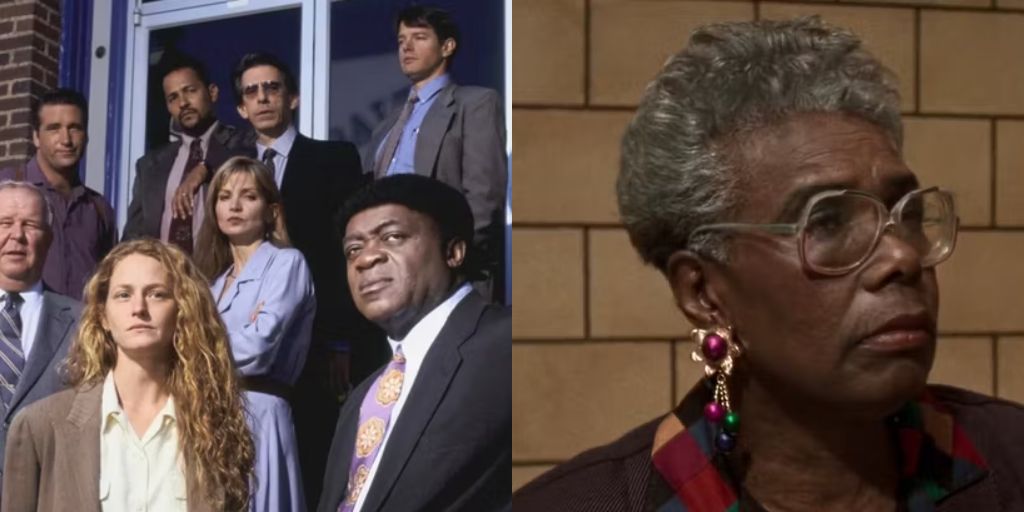The popular series Homicide: Life on the Street is now streaming on Peacock. This important police show was made by Tom Fontana and Barry Levinson. It is based on the true story Homicide: A Year on the Killing Streets by journalist David Simon, who later created The Wire.
The show has a great cast, including Richard Belzer, Andre Braugher, and Melissa Leo. Many of the cases in the show are based on real stories from Simon’s book.
One of the most shocking stories in the book is about Geraldine Parrish. This real case became a subplot about a woman named Calpurnia Church, played by Mary Jefferson, in the Season 1 episodes “Gone for Goode” and “Son of a Gun.”
In the show, Calpurnia is accused of having several husbands and family members killed for insurance money. However, the real story is even more shocking than what happens in the show.
The case started as an extortion case where Geraldine’s name was not mentioned at first, but a search uncovered much more. Some details were likely left out of the show because they seemed too unbelievable.
Geraldine Parrish Was “The Case to End All Cases”
In Homicide: A Year on the Killing Streets, David Simon calls the Geraldine Parrish case “The case to end all cases, the investigation that raises the act of murder to the level of theatrical farce.” The main investigator on this case was Detective Donald Waltemeyer, who inspired the character Meldrick Lewis, played by Clark Johnson, in Homicide: Life on the Street.
According to Simon’s book, the case started when a 28-year-old woman named Dollie Brown reported that her uncle wanted $5,000 to keep her from being killed by a hitman. The police did not understand why anyone would want to kill Dollie, who had no money.
However, someone had already tried to kill her twice. At first, Waltemeyer thought Dollie’s two attacks were just bad luck and that her uncle was trying to take advantage of her fears. He had Dollie wear a wire, arrested her uncle for extortion, and closed the case.
The police only looked at the case again when Rodney Vice, a suspect in another murder, tried to reduce his sentence by giving police information.
He said he knew a hitman who had worked for a woman named Geraldine for several years. He told police that Dollie would not die no matter how many times the hitman tried. Waltemeyer checked with Dollie and confirmed that her aunt was Geraldine Parrish.
After Vice talked to the detectives, they began reviewing open murder cases from the past three years. The murders of Geraldine’s brother-in-law and an old woman who rented a room in her house were never solved, and there was no known motive.

As reported in The Washington Post, the two hitmen Geraldine hired for those murders were arrested. After solving two murders, the police realized this case was much bigger and began a special investigation into Geraldine.
When detectives talked to Geraldine’s family, they were shocked by what they learned. None of the family members seemed surprised, and everyone knew what Geraldine was doing.
Many family members, tenants, friends, and neighbors had signed insurance policies where Geraldine was the beneficiary. They discovered that her family members feared her partly because they believed she had special powers and practiced voodoo.
Geraldine Parrish Terrorized Family, Tenants, and Even Married Her Own Nephew
A search of Geraldine’s house found a huge collection of papers showing all the insurance policies she benefited from, but it also uncovered several marriage licenses. Police found out that Geraldine was married to five men at the same time.
Two of these men lived with her and were taken downtown as witnesses. The police could not believe the details when they talked to the two men. One man, Johnnie Davis, was forced into marriage and lived in the basement while Geraldine took his disability checks each month.
The other man was Geraldine’s nephew, Milton Baines, who did not want to marry his aunt. Geraldine threatened him with a voodoo curse if he refused. Another husband, Reverend Rayfield Gilliard, was already dead when the investigation began. According to The New York Times, he died just fifteen days after marrying Geraldine. She received his social security benefits, his house, and about $1,000.
In Homicide: Life on the Street, they simplified the story by having Calpurnia’s niece tell the police that her aunt demanded $5,000 from her. The niece also revealed that Calpurnia had five husbands and life insurance policies on all of them.
Later, in the episode “Son of a Gun,” the detectives go over how many life insurance policies Calpurnia benefited from. By condensing the case into just a few scenes, the show did not fully capture how wild this investigation really was.
The thorough investigation took six months of Waltemeyer’s career and reopened many unrelated cases from the past three years.

The Calpurnia Church storyline is one of many cases in Homicide: Life on the Street that came from David Simon’s non-fiction book. While the show is famous for its realism, sometimes the real story is stranger than what is shown.
Homicide: Life on the Street is now streaming on Peacock. The series is based on David Simon’s book about true crime stories, including the shocking case of Geraldine Parrish, who married five men and took out insurance policies on them. The real stories are often stranger than fiction.
Homicide: Life on the Street is available to stream in the U.S. on Peacock.





